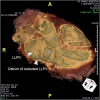Case report: a breathtaking complication after ablation-using multi-modal imaging for timely diagnosis of acquired pulmonary vein stenosis and its implication for effective management
- PMID: 36974104
- PMCID: PMC10039448
- DOI: 10.1093/ehjcr/ytad110
Case report: a breathtaking complication after ablation-using multi-modal imaging for timely diagnosis of acquired pulmonary vein stenosis and its implication for effective management
Abstract
Background: Acquired pulmonary vein stenosis (PVS) is a rare, but serious, complication that can develop after treatment with ablations for atrial fibrillation. Prompt diagnosis is difficult because it can often present similarly to other pulmonary disease processes.
Case summary: We describe a 62-year-old female with history of persistent symptomatic atrial fibrillation that resolved status post two radio-frequency ablations who presents with ongoing dyspnoea, productive cough, pleuritic chest pain, and haemoptysis over multiple admissions. She was misdiagnosed with recurrent pneumonias and pulmonary embolism that failed to improve her symptoms. She was referred to our centre for further evaluation finding severe stenosis in the left superior pulmonary vein with complete obliteration of the left inferior pulmonary vein on computed tomography scan. Multi-modal imaging including an echocardiogram and pulmonary angiogram was used to confirm the diagnosis. Percutaneous intervention with transvenous pulmonary vein venoplasty with pulmonary vein stenting of the left upper pulmonary vein was offered which resolved the patient's aforementioned symptoms.
Conclusion: Prompt diagnosis of acquired pulmonary vein stenosis is critical to plan for effective management. Our case highlights the need to consider PVS with a high index of clinical suspicion when a patient's medical history is significant for a prior history of ablation. We also review the use of multi-modal imaging to diagnose and plan for effective management with percutaneous intervention.
Keywords: Acquired pulmonary vein stenosis; Case report; Catheter ablation; Pulmonary vein stenting.
© The Author(s) 2023. Published by Oxford University Press on behalf of the European Society of Cardiology.
Conflict of interest statement
Conflict of interest: None declared.
Figures




Similar articles
-
A rare case of right heart failure with the necessity for veno-arterial extracorporeal membrane oxygenation following pulmonary vein stenosis after radiofrequency ablation for atrial fibrillation.Pulm Circ. 2023 Feb 21;13(1):e12189. doi: 10.1002/pul2.12189. eCollection 2023 Jan. Pulm Circ. 2023. PMID: 36824692 Free PMC article.
-
Acquired pulmonary vein stenosis resulting in haemoptysis: a case series.Eur Heart J Case Rep. 2021 Jun 30;5(6):ytab235. doi: 10.1093/ehjcr/ytab235. eCollection 2021 Jun. Eur Heart J Case Rep. 2021. PMID: 34222784 Free PMC article.
-
Incidence of Pulmonary Vein Stenosis After Radiofrequency Catheter Ablation of Atrial Fibrillation.JACC Clin Electrophysiol. 2017 Jun;3(6):589-598. doi: 10.1016/j.jacep.2017.02.003. Epub 2017 Apr 26. JACC Clin Electrophysiol. 2017. PMID: 29759432
-
Pulmonary vein stenosis complicating radiofrequency catheter ablation for atrial fibrillation: A literature review.Respir Med. 2016 Aug;117:215-22. doi: 10.1016/j.rmed.2016.06.014. Epub 2016 Jun 15. Respir Med. 2016. PMID: 27492534 Review.
-
Pulmonary veins stenosis after catheter ablation of atrial fibrillation as the cause of haemoptysis: three cases and a literature review.Clin Respir J. 2018 Jan;12(1):3-9. doi: 10.1111/crj.12501. Epub 2016 Jun 28. Clin Respir J. 2018. PMID: 27216646 Review.
References
-
- Saad EB, Marrouche NF, Saad CP, Ha E, Bash D, White RD, et al. . Pulmonary vein stenosis after catheter ablation of atrial fibrillation: emergence of a new clinical syndrome. Ann Intern Med 2003;138:634–638. - PubMed
-
- Edriss H, Denega T, Test V, Nugent K. Pulmonary vein stenosis complicating radiofrequency catheter ablation for atrial fibrillation: a literature review. Respir Med 2016;117:215–222. - PubMed
-
- De Greef Y, Ströker E, Schwagten B, Kupics K, De Cocker J, Chierchia GB, et al. . Complications of pulmonary vein isolation in atrial fibrillation: predictors and comparison between four different ablation techniques: results from the MIddelheim PVI-registry. Europace 2018;20:1279–1286. - PubMed
-
- Nanthakumar K, Mountz JM, Plumb VJ, Epstein AE, Kay GN. Functional assessment of pulmonary vein stenosis using radionuclide ventilation/perfusion imaging. Chest 2004;126:645–651. - PubMed
-
- Neumann T, Kuniss M, Conradi G, Sperzel J, Berkowitsch A, Zaltsberg S, et al. . Pulmonary vein stenting for the treatment of acquired severe pulmonary vein stenosis after pulmonary vein isolation: clinical implications after long-term follow-up of 4 years. J Cardiovasc Electrophysiol 2009;20:251–257. PMID: 19261037. - PubMed
Publication types
LinkOut - more resources
Full Text Sources
Research Materials
